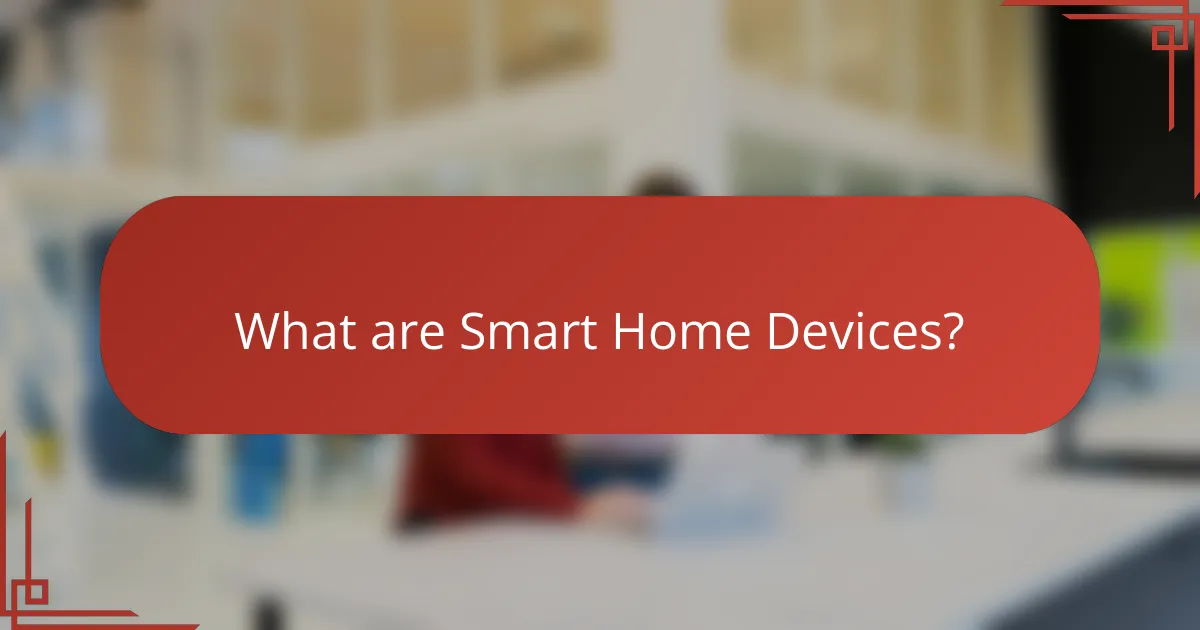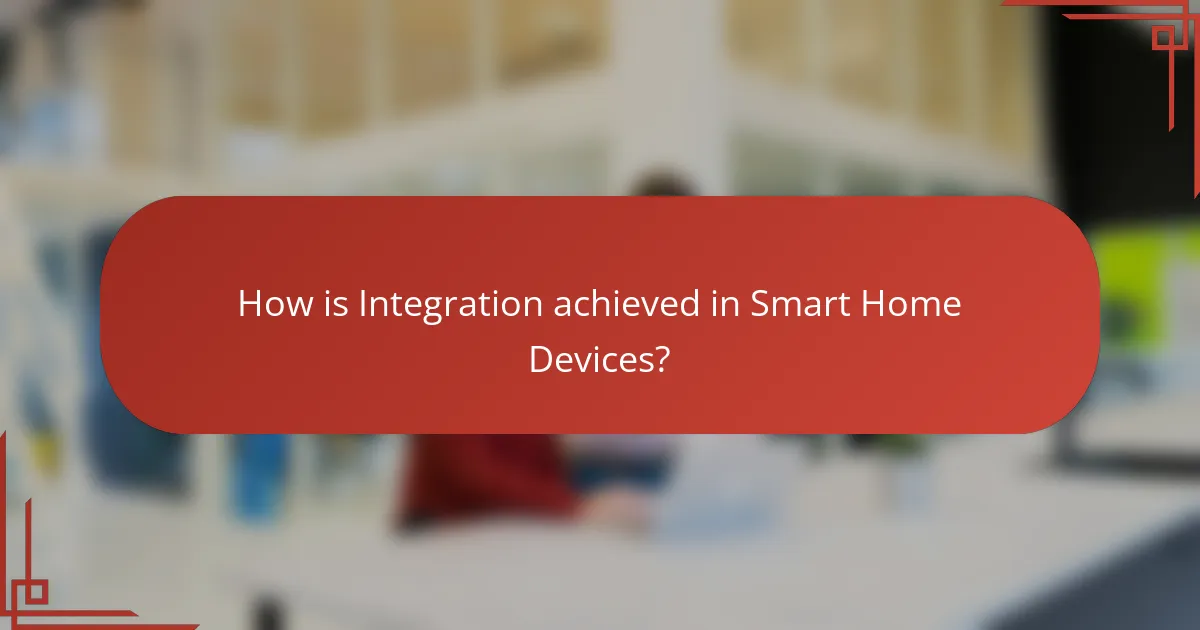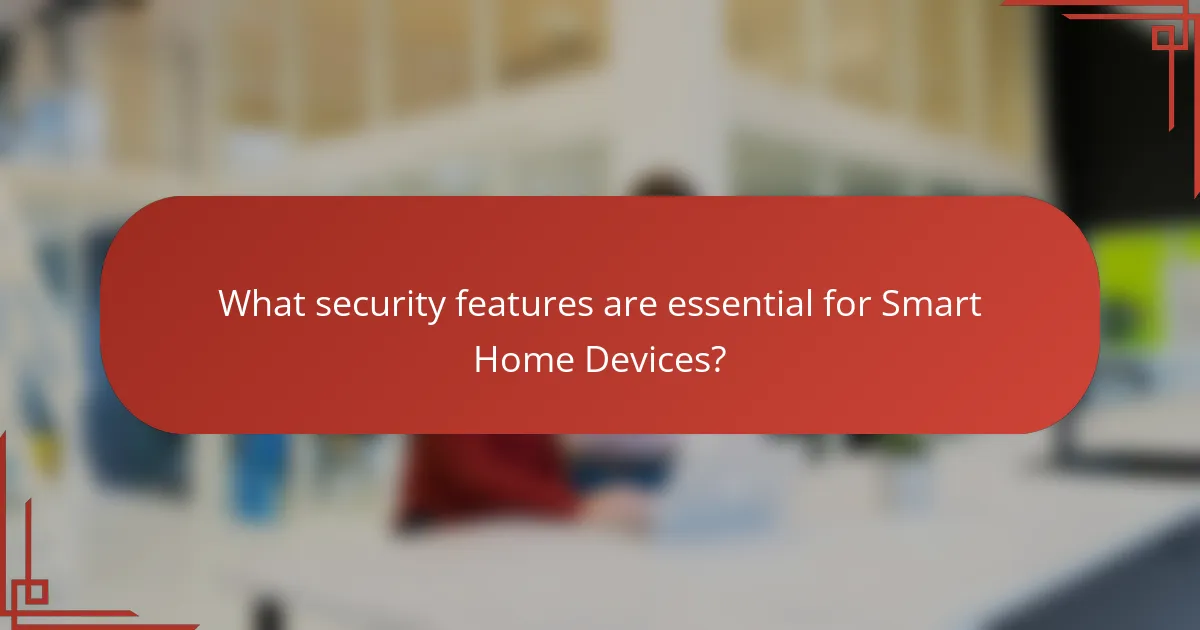Smart home devices are electronic gadgets designed for remote control and automation, enhancing convenience, efficiency, and security in residential settings. Common examples include smart thermostats, lights, and security cameras, which often integrate with mobile apps or voice assistants. The global smart home market, valued at approximately $80 billion in 2022, reflects significant consumer interest in these technologies. Integration is achieved through standardized communication protocols such as Zigbee, Z-Wave, and Wi-Fi, allowing seamless communication between devices from different manufacturers. Essential security features, including strong encryption, regular software updates, and secure user authentication, are critical for protecting smart home devices from unauthorized access and cyber threats.

What are Smart Home Devices?
Smart home devices are electronic gadgets that connect to a network for remote control and automation. They enhance convenience, efficiency, and security in residential environments. Common examples include smart thermostats, lights, and security cameras. These devices often integrate with mobile apps or voice assistants for user-friendly interaction. The global smart home market was valued at approximately $80 billion in 2022, indicating significant consumer interest. Smart home technology can reduce energy consumption and improve home security through real-time monitoring.
How do Smart Home Devices function?
Smart home devices function by connecting to a central hub or network, allowing control and automation. These devices use wireless communication protocols like Wi-Fi, Zigbee, or Z-Wave. Users can control them via smartphone apps, voice commands, or automated routines. Sensors in these devices gather data, enabling them to respond to environmental changes. For example, smart thermostats adjust temperature based on user preferences and occupancy. Security cameras can send alerts when motion is detected. Integration with other smart devices enhances functionality, creating a cohesive smart home ecosystem. This interconnectedness improves convenience, energy efficiency, and security for users.
What technologies enable the operation of Smart Home Devices?
Smart home devices operate using several key technologies. These include Wi-Fi, Bluetooth, Zigbee, and Z-Wave. Wi-Fi allows devices to connect to the internet for remote access and control. Bluetooth provides short-range connectivity for device pairing and communication. Zigbee is a low-power protocol for device networking, ideal for smart home applications. Z-Wave operates similarly, focusing on low-energy communication between devices. These technologies enable seamless integration and functionality of smart home systems. Studies show that over 70% of smart home devices use Wi-Fi as their primary communication method.
How do Smart Home Devices communicate with each other?
Smart home devices communicate with each other primarily through wireless protocols. These protocols include Wi-Fi, Zigbee, Z-Wave, and Bluetooth. Each protocol has its own specifications for data transmission. Wi-Fi allows for high-bandwidth communication suitable for video streaming. Zigbee and Z-Wave are designed for low-power devices, enabling longer battery life. Bluetooth is often used for short-range connections.
Devices connect to a central hub or directly to each other. The hub acts as a coordinator, managing commands and data flow. Smart home devices can also utilize cloud services for remote access and automation. This enables users to control devices from anywhere via smartphone apps.
Research indicates that interoperability among devices enhances user experience. According to a report by the Consumer Technology Association, 70% of users prefer devices that can work together seamlessly. This integration is crucial for creating a cohesive smart home ecosystem.
What are the key benefits of Smart Home Devices?
Smart home devices offer numerous benefits, including convenience, energy efficiency, and enhanced security. They allow users to control home functions remotely through smartphones or voice commands. This automation simplifies daily tasks, such as adjusting thermostats or turning on lights. Energy efficiency is achieved by optimizing usage patterns, potentially reducing utility bills by 10-30% (Energy Star). Enhanced security features include real-time monitoring and alerts, which can deter intruders. Studies show that homes with smart security systems experience a lower burglary rate. Overall, smart home devices improve lifestyle quality and provide peace of mind.
How do Smart Home Devices enhance convenience in daily life?
Smart home devices enhance convenience in daily life by automating routine tasks. They allow users to control home functions remotely via smartphones or voice commands. For instance, smart thermostats adjust temperatures automatically based on user preferences. Smart lighting systems can be programmed to turn on or off at specific times. Security cameras provide real-time monitoring, enhancing safety without manual checks. Smart appliances, like refrigerators, can notify users about expiration dates. According to a study by Statista, 63% of smart home device users report increased comfort and ease in their daily routines. This automation saves time and reduces manual effort, making life more efficient.
What energy-saving features do Smart Home Devices offer?
Smart home devices offer several energy-saving features. These devices include smart thermostats that optimize heating and cooling schedules. They adjust temperatures based on occupancy and preferences. Smart lighting systems allow users to control lights remotely and set schedules. This reduces energy waste when rooms are unoccupied. Energy monitoring plugs track energy consumption of connected devices. They provide insights to help users reduce usage. Some smart appliances operate during off-peak hours to save on energy costs. According to the U.S. Department of Energy, smart thermostats can save homeowners an average of 10-12% on heating and cooling bills annually. These features collectively contribute to energy efficiency in smart homes.
How do Smart Home Devices contribute to home security?
Smart home devices enhance home security through real-time monitoring and automation. They include smart cameras, door locks, and alarms that can be controlled remotely. Smart cameras provide video feeds accessible via smartphones, allowing homeowners to monitor their property at any time. Smart door locks enable keyless entry and can be locked or unlocked remotely. Alarms can be triggered by motion detection or unauthorized access, alerting homeowners instantly. According to a study by the Security Industry Association, homes with smart security systems are 300% less likely to be burglarized. This data underscores the effectiveness of smart home devices in deterring crime and ensuring safety.

How is Integration achieved in Smart Home Devices?
Integration in smart home devices is achieved through standardized communication protocols and platforms. These protocols, such as Zigbee, Z-Wave, and Wi-Fi, allow devices from different manufacturers to communicate seamlessly. Smart home hubs centralize control and facilitate interoperability among devices. For instance, platforms like Google Home and Amazon Alexa support a wide range of devices, enabling voice control and automation. Additionally, APIs (Application Programming Interfaces) allow developers to create applications that enhance compatibility. This integration improves user experience by providing centralized management and automation capabilities. Statistics show that over 70% of smart home users prefer devices that work together seamlessly.
What platforms facilitate the integration of Smart Home Devices?
Several platforms facilitate the integration of Smart Home Devices. Popular platforms include Amazon Alexa, Google Assistant, and Apple HomeKit. These platforms enable users to control various smart devices through voice commands or mobile apps. They support a wide range of devices, enhancing interoperability. Additionally, platforms like SmartThings and IFTTT allow for automation and customization of smart home setups. Research shows that these platforms improve user experience and device compatibility, making smart homes more efficient.
How do voice assistants play a role in Smart Home integration?
Voice assistants are central to Smart Home integration. They serve as the primary interface for controlling smart devices. Users can issue voice commands to manage lighting, thermostats, and security systems. This hands-free operation enhances convenience and accessibility. Voice assistants support various protocols, allowing seamless communication between devices. They also enable automation by setting routines based on user preferences. According to a 2022 report by Statista, 60% of smart home device owners use voice assistants for management. This statistic underscores their significance in enhancing user interaction with smart technology.
What protocols are commonly used for device interoperability?
Common protocols used for device interoperability include Zigbee, Z-Wave, and Wi-Fi. Zigbee is a low-power, wireless mesh networking protocol designed for short-range communication. It is widely used in smart home devices due to its ability to connect multiple devices seamlessly. Z-Wave operates similarly, focusing on home automation and providing reliable communication between devices. Wi-Fi is a well-known protocol that enables devices to connect to the internet and communicate with each other. Each of these protocols allows for diverse devices from different manufacturers to work together effectively in smart home environments.
What challenges exist in the integration of Smart Home Devices?
Integration of Smart Home Devices faces several challenges. Compatibility issues arise due to varying standards and protocols among devices. Many devices may not communicate effectively with each other. This lack of interoperability can lead to functionality problems. Network security is another significant challenge. Smart home devices are vulnerable to hacking and unauthorized access. Data privacy concerns also exist, as personal information may be collected and shared without user consent. Additionally, user complexity can hinder adoption. Many consumers find setup and management of these devices confusing. Finally, high costs can be a barrier, as advanced smart home systems can be expensive to implement.
How can compatibility issues be resolved?
Compatibility issues can be resolved by ensuring that devices use standardized protocols. Standard protocols like Zigbee and Z-Wave facilitate communication between different manufacturers. Updating device firmware can also address compatibility problems. Manufacturers often release updates to improve interoperability. Additionally, using a smart home hub can unify devices from various brands. Hubs translate signals and commands, allowing seamless integration. Consulting compatibility lists from manufacturers can guide device selection. This ensures that new purchases will work with existing systems.
What role does user interface design play in successful integration?
User interface design plays a crucial role in the successful integration of smart home devices. It facilitates user interaction with various interconnected devices. An intuitive interface enhances user experience and promotes seamless operation. Effective design reduces the learning curve for users. It allows for easy navigation and control of multiple devices from a single platform. Research indicates that 70% of users prefer systems with user-friendly interfaces. This preference directly impacts user satisfaction and device adoption rates. A well-designed interface also helps in troubleshooting and managing device settings efficiently. Thus, user interface design significantly influences the overall success of smart home integration.

What security features are essential for Smart Home Devices?
Essential security features for smart home devices include strong encryption, regular software updates, secure user authentication, and network security protocols. Strong encryption protects data transmitted between devices. Regular software updates address vulnerabilities and improve security. Secure user authentication, such as two-factor authentication, adds an extra layer of protection. Network security protocols like WPA3 enhance the security of wireless connections. Together, these features help safeguard smart home devices from unauthorized access and cyber threats.
How do Smart Home Devices protect user data?
Smart home devices protect user data through encryption and secure communication protocols. Encryption scrambles data, making it unreadable to unauthorized users. Secure communication protocols, such as TLS, safeguard data during transmission. Many devices also implement regular software updates to fix vulnerabilities. User authentication measures, like two-factor authentication, enhance security further. Device manufacturers often adhere to privacy regulations, ensuring compliance with data protection laws. According to a 2021 study by the International Journal of Information Security, devices using strong encryption showed a 70% reduction in data breaches. These methods collectively help in maintaining user privacy and data integrity.
What encryption methods are commonly used in Smart Home security?
Common encryption methods used in Smart Home security include AES, RSA, and TLS. AES, or Advanced Encryption Standard, is widely used for securing data due to its strength and efficiency. RSA, or Rivest-Shamir-Adleman, is a public-key encryption method that enables secure data transmission. TLS, or Transport Layer Security, ensures that data sent between devices is encrypted and secure. These methods help protect user data from unauthorized access and cyber threats. Their adoption is critical in maintaining the integrity of Smart Home systems, as highlighted by industry standards and best practices.
How can users enhance the security of their Smart Home Devices?
Users can enhance the security of their Smart Home Devices by implementing strong passwords and enabling two-factor authentication. Strong passwords should be unique and complex, consisting of letters, numbers, and symbols. Two-factor authentication adds an extra layer of security by requiring a second form of verification. Regularly updating device firmware is crucial, as manufacturers often release security patches. Users should also disable features like remote access if not needed, as they can create vulnerabilities. Additionally, segmenting the home network can limit exposure to potential attacks. Using a secure Wi-Fi network with encryption helps protect devices from unauthorized access. According to a report from the Cybersecurity & Infrastructure Security Agency (CISA), these measures significantly reduce the risk of breaches.
What are the implications of security breaches in Smart Home Devices?
Security breaches in smart home devices can lead to significant privacy violations and unauthorized access to personal data. These breaches allow hackers to control devices remotely, potentially leading to theft or property damage. According to a study by the Ponemon Institute, 63% of consumers express concerns about the security of smart home devices. Additionally, security breaches can result in financial loss due to identity theft or fraud. The compromised data can include sensitive information such as passwords and bank details. Furthermore, these incidents can erode consumer trust in smart technology, impacting adoption rates. In 2020, cyberattacks on IoT devices increased by 50% compared to the previous year, highlighting the growing threat. Overall, the implications of security breaches in smart home devices are profound, affecting personal security, financial stability, and consumer confidence.
How do security breaches affect user trust in Smart Home technology?
Security breaches significantly undermine user trust in Smart Home technology. When users hear about incidents of unauthorized access, they become concerned about their privacy and safety. A study by the Ponemon Institute found that 60% of consumers are less likely to purchase smart home devices after hearing about security breaches. Users feel vulnerable when their personal data is at risk. This vulnerability leads to skepticism about the reliability of smart home systems. Trust diminishes as consumers worry about potential hacks and data theft. Consequently, manufacturers may face declining sales and reputational damage. Therefore, security breaches create a cycle of distrust that can hinder the growth of smart home technology.
What measures can be taken to mitigate risks associated with breaches?
Implementing strong security measures is essential to mitigate risks associated with breaches. This includes using strong, unique passwords for each device. Regularly updating device firmware can close security vulnerabilities. Employing network segmentation isolates smart devices from critical systems. Utilizing a virtual private network (VPN) can enhance privacy and security. Enabling two-factor authentication adds an extra layer of protection. Monitoring network traffic helps identify unusual activities promptly. Educating users about phishing attacks reduces the likelihood of social engineering breaches. According to the Cybersecurity & Infrastructure Security Agency, these strategies significantly lower the risk of unauthorized access.
What best practices should users follow for Smart Home Device management?
Users should follow several best practices for Smart Home Device management. First, they should regularly update device firmware and software. Keeping devices updated enhances security and functionality. Second, users should change default passwords to unique, strong passwords. This reduces the risk of unauthorized access. Third, users should segment their network. Placing smart devices on a separate network can enhance security. Fourth, they should enable two-factor authentication where available. This adds an extra layer of protection. Fifth, users should regularly review and manage device permissions. Limiting access can prevent data breaches. Lastly, users should monitor device activity for unusual behavior. This helps in identifying potential security threats. Following these practices can significantly improve the management and security of smart home devices.
Smart home devices are electronic gadgets that connect to a network for remote control and automation, enhancing convenience, efficiency, and security in residential environments. This article explores the functionality of smart home devices, the technologies enabling their operation, and the key benefits they offer, such as energy savings and improved home security. Additionally, it addresses the integration of these devices through standardized protocols, the challenges faced in achieving compatibility, and essential security features to protect user data. By examining these aspects, the article provides a comprehensive overview of the rise of smart home devices and their impact on modern living.


